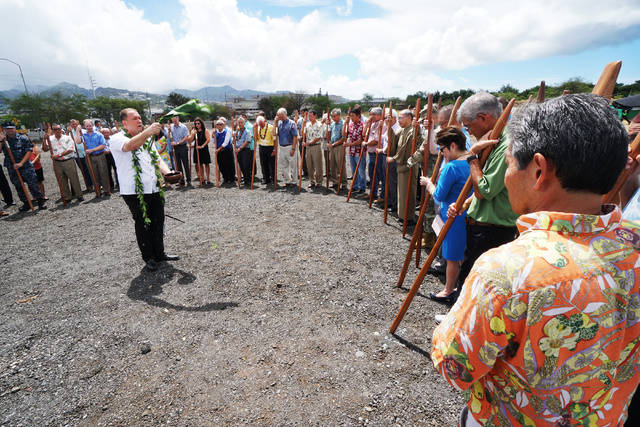It’s still just an empty piece of public land, but one with the promise of new opportunities for some 150 homeless families desperate for a bit of good fortune.
The site of the future Kahauiki Village, an 11.3-acre parcel the state transferred to the city for this purpose, will become a place that should yield no small measure of hope — and soon. The aim is to move the first 30 families into 18 two-bedroom and 12 one-bedroom units before Christmas.
Even when all 600 or so people are accommodated within the completed village, located near Keehi Lagoon, it will represent just a small sliver of the homeless population of Oahu. This can be a solution for one homeless constituency in need of help — the working poor, with families — but is not geared for all living with homelessness, with all its complexities.
This project is impressive not because it purports to resolve all homelessness issues (it doesn’t), but because of its rather visionary approach that encourages both self-reliance and mutual support.
What can and should be replicated from this initiative is collaboration to overcome hurdles.
Kahauiki Village’s concept was devised by Hawaii businessman Duane Kurisu, who grew up in a plantation village and believes recreating that environment could help reclaim lives.
Kurisu is repurposing prefabricated units that had been purchased originally to help those who lost their homes six years ago in the devastating Japan tsunami and nuclear reactor disaster. These are modular dwellings built and dispatched as part of the “Aloha for Japan” charity fundraiser. Kurisu, a board member for Oahu Publications Inc., the Honolulu Star-Advertiser’s parent company, helped to organize that event.
Even with the land provided and the dwellings essentially purchased, the undisclosed costs of the project continue to mount. And another asset in Kahauiki Village’s immense potential — nearby job opportunities for those willing and able to work — might not materialize readily for another project. That piece, contributed by former first lady Vicky Cayetano, is the willingness to hire workers from the village at her United Laundry business, which is within walking distance.
In what is becoming the best kind of public-private partnership, the development of the village also involves the work of nonprofits. It is an enterprise of Kurisu’s own aio Foundation, which will lease the land from the city at $1 a year.
Success also will depend on the work of groups such as Salvation Army and Catholic Charities Hawaii, which will provide programs readying the families before they move in.
It will be managed by the Institute for Human Services, which will do the essential task of screening potential residents, to find those willing to invest their own labor and the money they earn. These are not free homes but will be rented to the occupants at affordable rates: $900 monthly for two-bedroom homes, $725 for the one-bedroom units, all of them including electricity, gas and water service.
This is meant not as transitional housing but a place to call home, Gov. David Ige said at Tuesday’s groundbreaking. It’s not necessarily a final stop but represents a supportive neighborhood, where there will be a child-care center enabling parents to work at a job and be solid contributing members of the state economy.
Further — and most important — it will be a haven for children, who should grow up in calm and stability not afforded by life on the street.
Children need such things as they need food and water. The larger community needs them to have hope that they can break this cycle of poverty, see their own potential and realize it. It can take a village — in this case, a plantation village — to raise a child.

